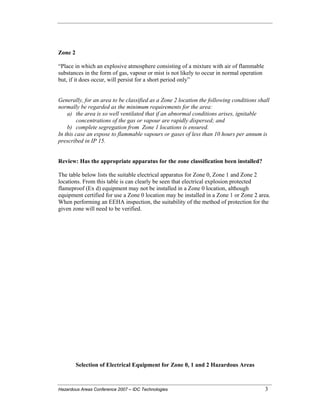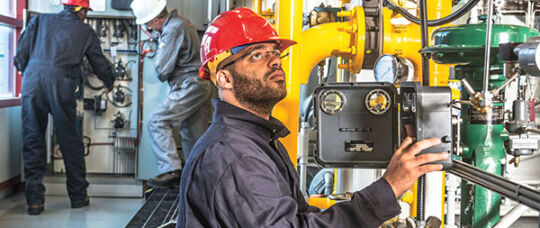Roar Solutions for Beginners
Roar Solutions for Beginners
Blog Article
Unknown Facts About Roar Solutions
Table of ContentsThe 7-Minute Rule for Roar SolutionsRoar Solutions Fundamentals ExplainedThe 5-Minute Rule for Roar Solutions
In order to protect installations from a possible explosion a method of evaluating and classifying a possibly harmful area is called for. The purpose of this is to guarantee the proper choice and installment of devices to eventually avoid a surge and to make sure safety of life.
(https://dc-washington.cataloxy.us/firms/training.roarsolution.com.au.htm)
No tools needs to be set up where the surface temperature of the equipment is higher than the ignition temperature of the offered threat. Below are some usual dirt hazardous and their minimum ignition temperature. Coal Dust 380C 225C Polythene 420C (thaws) Methyl Cellulose 420C 320C Starch 460C 435C Flour 490C 340C Sugar 490C 460C Grain Dust 510C 300C Phenolic Material 530C > 450C Aluminium 590C > 450C PVC 700C > 450C Residue 810C 570C The chance of the risk being existing in a concentration high adequate to cause an ignition will differ from location to location.
In order to categorize this threat an installation is divided into areas of threat depending upon the quantity of time the hazardous exists. These locations are described as Zones. For gases and vapours and dirts and fibres there are three zones. Area 0 Area 20 A harmful environment is extremely most likely to be present and may exist for long periods of time (> 1000 hours each year) and even constantly Zone 1 Zone 21 A dangerous environment is possible but not likely to be existing for extended periods of time (> 10 450 C [842 F] A classification of T6 means the minimum ignition temperature level is > 85 C [185 F] Dangerous location electrical equipment maybe developed for usage in greater ambient temperature levels. This would certainly indicated on the score plate e.g. EExe II C T3 Ta + 60C( This implies at 60C ambient T3 will certainly not be gone beyond) T1 T1, T2, T3, T4, T5, T6 T2 T2, T3, T4, T5, T6 T3 T3, T4, T5, T6 T4 T4, T5, T6 T5 T5, T6 T6 T6 A T Course ranking of T1 implies the optimum surface temperature level generated by the tool at 40 C is 450 C. Presuming the associated T Class and Temperature level rating for the devices are appropriate for the area, you can always make use of a tool with a more stringent Department ranking than needed for the area. There isn't a clear response to this concern however. It actually does depend on the type of devices and what fixings need to be brought out. Tools with details examination treatments that can not be done in the field in order to achieve/maintain 3rd party rating. Must come back to the manufacturing facility if it is prior to the tools's service. Field Repair Service By Authorised Employee: Complicated screening may not be required however certain procedures might require to be complied with in order for the tools to keep its third party score. Authorised personnel have to be used to do the job correctly Repair service must be a like for like substitute. New element must be thought about as a direct substitute calling for no unique screening of the tools after the repair work is total. Each item of devices with a harmful rating need to be assessed separately. These are outlined at a high degree listed below, but also for even more comprehensive information, please refer straight to the standards.
Little Known Questions About Roar Solutions.
The devices register is a detailed data source of equipment records that consists of a minimum collection of fields to recognize each product's area, technical parameters, Ex-spouse category, age, and environmental data. The ratio of Detailed to Close assessments will certainly be determined by the Devices Risk, which is examined based on ignition danger (the chance of a resource of ignition versus the probability of a combustible ambience )and the unsafe area classification
( Zone 0Area 1, or 2). Implementing a robust Risk-Based Examination( RBI )approach is critical for guaranteeing conformity and safety in taking care of Electrical Equipment in Hazardous Areas( EEHA).
The Ultimate Guide To Roar Solutions

In regards to explosive threat, a hazardous location is an environment in which an explosive ambience is existing (or might be anticipated to be existing) in quantities that call for special precautions for the building, installment and use equipment. hazardous area electrical course. In this post we discover the obstacles dealt with in the work environment, the danger control procedures, and the required expertises to work safely
These substances can, in particular conditions, develop eruptive environments and these can have significant and heartbreaking effects. Many of us are familiar with the fire triangular get rid of any kind of one of the 3 elements and the fire can not occur, however what does this mean in the context of harmful locations?
In a lot of circumstances, we can do little concerning the levels of oxygen airborne, yet we can have substantial impact on resources of ignition, for instance electric devices. Harmful locations are recorded on the harmful area classification drawing and are determined on-site by the triangular "EX LOVER" indicator. Below, amongst other crucial information, zones are split into three go to this web-site kinds depending upon the hazard, the possibility and period that an eruptive ambience will certainly exist; Area 0 or 20 is considered the most hazardous and Zone 2 or 22 is considered the least.
Report this page